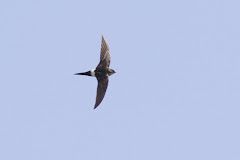The forecast for saturday morning was for a front to pass through from the south-west with rain beginning around 9am. The weather chart showed that the airflow was coming from the east/south-east. I thought it potentially looked good for migrant birds which would be flying in a north-easterly direction before being grounded by the oncoming rain front. In the event, there were hardly any passerines (small birds) at all but the 3 hours spent at Kongelunden were not without their reward. First, an Osprey patrolled the coast, passing me several times and catching at least 2 pipefish (I believe they are pipefish but someone may know better). Shortly after the Osprey caught its first fish and perched inland to devour it, Steffen picked up a 'ringtail' harrier going east over the sea towards Sweden. We both got our 'scopes on it right away and began to piece together the evidence... A 'ringtail' harrier (the term for a female or young harrier) could be one of three species. The most common is the Hen Harrier (a fairly common bird, especially in winter). The more exciting are the Montagu's Harrier and the Pallid Harrier. 'Our' bird was at a fair distance but the most striking feature was the broad dark patch on the secondaries (inner wing) on both the upper and under wing that looked as if it included the secondary coverts. The wings were relatively narrow compared with Hen Harrier and its overall 'jizz' ruled out this species. I don't have a lot of experience of the other two possible Harrier species (I have only seen a handful of adult Montagu's Harriers and one adult male and one juvenile Pallid Harrier) so I wasn't sure which it was. Steffen thought it was a Pallid, so we tried to ascertain other features. We could not make out the 'boa' that is typical of Pallid Harrier and relative arm and hand breadth was difficult to see, so we didn't have all the evidence that we would have liked. On looking at some photos on the web on my return I think
this Montagu's is a reasonable match of the underwing pattern but then so is
this Pallid. It did look darkish on the belly unlike the Montagu's pictured here and the 'boa' is not always obvious from distance apparently. Steffen was pretty sure it was a Pallid and was confident enough to put the news out (he has seen around 6 Pallids in Denmark previously). I think I have to plump for a 'probable Pallid'. Unfortunately I didn't even think to try for a record photo as we were too busy grilling it to try to nail the id while the bird was in view. It was heading towards Falsterbo, so hopefully it has been picked up there (probably would have reached there around 8am..). Will check the Swedish sightings later today to see.
In the meantime, here are a few photos of the Osprey with a wriggly pipefish.










2 comments:
hi terry
they are actually garfish, I got round to looking it up today. Same species we saw that osprey carrying at Sandön on Thursday.
Thanks Phil, that makes sense (just looked them up). Apparently they have green bones which puts people off eating them but they are allegedly great to eat... certainly seem popular with the local Ospreys.
Post a Comment